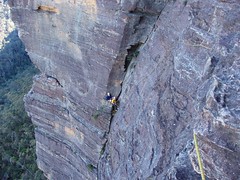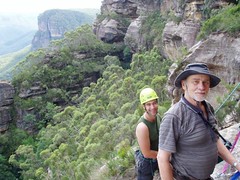By Rod Smith
From below the block looked loose, really loose. The type of loose where you’re convinced that your soft head and a hard chunk of Wolgan Valley cliff are about to collide.
Now that I’m hugging it doesn’t mean that I’m convinced that this block is any more secure. It’s simply the fact that once above it I’ll be in the sheltered cave that marks the end of the first pitch of Secret Swinger (16). The place where I plan to hand over the reins to Paul Turner.
As I pull up and over the block and into the cave I’m feeling good. Strong. Confident even. My first real trad lead in eight years is almost over. It’s been terrifying and exhilarating. Now I have this sheltered mid-climb haven to rest in and prepare for the second pitch. Then I look around.
It quickly becomes apparent that this cave is no more than a wind and water-blasted scoop. The fragile, honey-combed walls are only marginally less disturbing than the hundreds of fist-sized rocks and dozens of chunks of cliff that make that loose block below look as if it’s welded to the cliff. In between blasts of word-snatching wind I call down in a small voice to Paul, “The place is falling apart. I can’t find an anchor. It may take me some time…”
Time. It’s something that the Wolgan demands of you and soaks up like a sponge.
It took plenty of time to drive there from Sydney. Three hours in Paul’s big, comfortable Commodore station wagon, cruising with enough gear, food, water and home brew to last the best part of three days.
The plan was to leave Friday night and descend into the valley of the mobile phone coverage shadow ready for an early morning start on the crags on Saturday. Then it bucketed down, forcing us to delay our departure.
By late Saturday morning we were surveying the ford across the Wolgan River, about the same time as the run-off from Friday’s downpour arrived. Paul assured me it would be OK. We watched as Niall Doherty and Anna Beardmore in Anna’s near-new all-wheel drive easily made it through the brown waters. We followed quickly and easily. Then along came Ron Garner.
On the roof racks of Ron’s Volvo there appeared to be a dangerous amount of home-brewed beer. I’m convinced that it was the weight of the pallets of home brew that caused Ron’s car to stall mid-stream in the suitably beer-coloured waters of the river.
With his passengers ankle-deep in rising waters in the backseat, Ron was forced to use the driver’s window as an exit. On the far bank a rescue mission was swinging into action. Borrowed karabiners and Ron’s climbing rope were used to connect the Swedish Valiant to Anna’s shiny, Subaru.
With crowds looking on Paul dragged Ron to safety causing Anna’s Subaru gearbox to erupt into a spontaneous celebration of billowing, black smoke. While Anna and Niall inspected the damage Ron was nonchalantly using a beer stein to bale the water out of the Volvo’s backseat.
With the riverside dramas behind us, and Anna’s car seemingly intact, we quickly set up camp at Southside. With the shadows lengthening into mid-afternoon someone finally made a decision to try some routes above the Coke Ovens. It was such a good idea that when we puffed our way up the hill just about everyone else was also there.
Nigel Donnelly and Mike Patterson were already mopping up on the rarely attempted Grunter Direct Finish (16). Like most of the valley’s relatively under-utilised routes, it’s an area with its share of small, lose rock. This was underlined by shouted warnings from Mike and Nigel followed by sandstone shrapnel raining down on those at the bottom. It also emphasised why helmets are essential kit in the Wolgan.
Nearby a few other helmeted heads, including “Big” Mike O’Reilly and “Diamond” Dave Hemmings, were mulling over the guidebook and spying out routes. It’s during this discussion that Big Mike managed to provoke a verbal stoush with a Scottish female photographer friend of Nigel’s. The big fella was quoting a line from the movie Trainspotting, something about “It’s shite being Scottish”, of which the wee lassie had apparently not heard before and took instant umbrage.
Our attention returned to the cliff as Dave Goldie and Ron tackled the classic Mike Law jamming problem Sizzler (19). It was Ron’s lead and when he cracked the puzzle it was to wild applause, in recognition of his determination to tick a route from which he had previously fallen and buggered an ankle.
Before this triumph Ron and Sandra Parker had ticked Organ Grinder (14) while Dave and Julie Hatfield had done the classic Mirrorman (18). Sandra also led Death Bed Confessions (13) with Hugh Ward and the pair also completed Grunter (16).
After Ron’s effort on Sizzler it was Paul and Niall’s turns. Anna accompanied Niall on Death Bed Confessions, perhaps the day’s most popular climb, while Paul decided to lead something that he assured me was called Sod (13).
At the top of the first pitch Paul offered me the sharp end but I declined, content to coast behind and take it all in – the airiness, the views and the warm sun of the golden afternoon. As I seconded the final pitch of Sod all that I was concerned about was my form – for a 13 it seemed a bit tricky for the grade. Puzzled by what we were supposed to have climbed, Paul checked the guidebook to discover his warm-up 13 was in fact the two-star classic Dan the Bulldog (17).
About the time we rapped down Nigel and Mike were completing the first pitch of DBC. Over on Sizzler Wall the queues were also forming. But it was from the direction of DBC that a shout of “rock” sent us scurrying for cover. And it was much more than shrapnel. One of the loose blocks that Niall had warned Anna about on DBC had broken off in Nigel’s hand.
“Nigel ripped a brick-sized chunk of rock from DBC,’’ Mike recalled.
“Fortunately Nigel was belayed from above but the less fortunate rock took the full 50m dive, narrowly avoiding killing the innocent bystanders but still ricocheting into Niall’s chest.’’
Luckily for Niall the rock hit squarely on the straps of his padded Black Diamond double bandolier, reducing the force of the blow from skin-ripping to simply agonising.
At this point we decided to call it a day.
Elsewhere in the valley others were also making the most of their Saturday. While Jonas Kuginis was, in his words “too chicken to drive” his car through the ford and camped elsewhere, it had no bearing on his climbing. He and Moto headed for the Coal Mines and completed Absolutely Sweet Marie (14), TDM (20), “an 18 I cannot remember” and Dien Bien Phu (22).
Saturday night saw the whole campsite join in the celebration of Garth Rickert’s 40th birthday. As well as a huge cream cake, Ron’s home brew made an appearence as did the birthday boy’s own 60-plus bottles of homemade ale and sundry smaller contributions from other hop enthusiasts – of both DIY and store-bought varieties.
The result was large numbers of significantly impaired people waking up to a perfect climbing day on Sunday morning.
As had happened on Saturday the collective mind took over on Sunday resulting in a long line of people heading for the delights of Old Baldy. Mike Patterson confessed that he was “virtually incapacitated” by the previous night’s festivities and only just managed the walk up to the cliff.
A minor revival allowed him to second What’s In A Name? (14) followed by a relapse that saw him agree to lead the “interesting” second and crux pitch. Mike’s colleagues Jim Croft and Chris Thomas completed Anthrax Ripple (14), Homesick (12) and Go Cat (16).
It was at Lower Baldy that Paul and I found ourselves gazing up at Secret Swinger, which had been heartily recommended to us by Niall who’d climbed it two years previously. As we roped up Niall and the rest of the gang headed off in a westerly direction.
Niall and Anna eventually settled on pitch one of Time Lord (17) and Niall completed half of Anthrax Ripple (13), before somewhat enigmatically stating he “didn't like the lichen”.
Back at Secret Swinger Paul was fending off Dave Goldie who wanted to give the route a go as I was freaking out looking at the crack. In retrospect I should probably deferred to Dave. It’s already been stated how I went on the first pitch. That’s why by the time Paul made it to the sandy, chossy cave at the end of the first pitch I was keen for him to lead the second. Unfortunately he remained equally keen for me to do it.
Whimpering about exposure and cursing Niall for failing to mention what a fragile chunk of rock this was, I pulled out of the cave and over the easy roof. The next 20m of climbing are a blur except for key points like when two of Paul’s Camalots plummeted to the deck, quickly followed by a poorly placed hex that was supposed to be bomber.
Four marathon hours after I’d begun bumbling my way up the climb Paul arrived at the second pitch belay. It was almost telepathic how Paul and I decided that we’d skip the short third pitch, rap off a tree and flee back to camp.
By the time we got back “Bomber” Nigel and his gang – who’d had a look at the Pulpit (8) among other Lower Baldy classics - were stretched out on the grass watching some hardy souls on Excalibur (17) on Upper Baldy.
Not long after those two tiny dots, one of which was apparently Andrew Penney, finally made it to the top the heavens opened up. Sodden climbers began returning to the camp in dribs and drabs all with tales of mini epics on a day that had flipped through all four seasons.
Among the groups caught in the wet was Ron, Dan Redfern and Lachie. After climbing The Square (13) on Lower Baldy, Ron and Dan had continued up the Amphitheatre (10) on Upper Baldy while Lachlan walked off the halfway ledge to wait for them at Solo Gully. It was after they rejoined Lachlan that darkness and rain descended. With their gear still at the base of The Square the trio decided to abandon it until the next day and as a result were forced to navigate back to camp by the light of one head torch.
After a night of sporadic rain those of us who stayed on Sunday night were greeted by a hot and fine holiday Monday. After lots of debate Niall and I headed back up to the Coke Ovens to have a look at Grunter while Anna and Paul decided to take in the sights. Halfway up the first pitch of Grunter, bombarded by March flies and wishing I’d gone sightseeing too I announced to Niall that I’d had enough.
Not needing much convincing he agreed and we headed back to camp to begin the big pack up.
A few hours later we were on the road. As Paul and I drove out of the valley on the return to Sydney, and our mute mobile phones once more chattered back to life, I promised myself that I would return very soon to this magical place where the climbs demand respect and the beer flows like Wolgan Valley river water.




